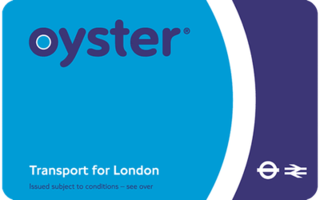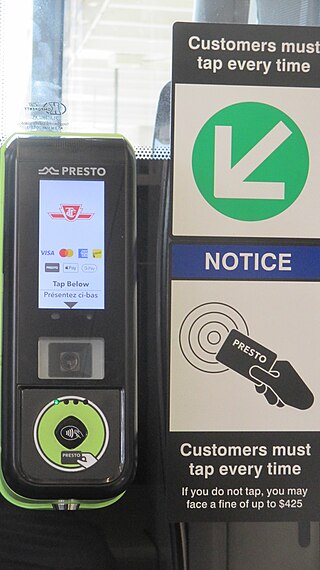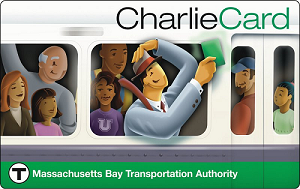
The Oyster card is a payment method for public transport in London in England, United Kingdom. A standard Oyster card is a blue credit-card-sized stored-value contactless smart card. It is promoted by Transport for London (TfL) and can be used on travel modes across London including London Buses, London Underground, the Docklands Light Railway (DLR), London Overground, Tramlink, some river boat services, and most National Rail services within the London fare zones. Since its introduction in June 2003, more than 86 million cards have been used.

A ticket machine, also known as a ticket vending machine (TVM), is a vending machine that produces paper or electronic tickets, or recharges a stored-value card or smart card or the user's mobile wallet, typically on a smartphone. For instance, ticket machines dispense train tickets at railway stations, transit tickets at metro stations and tram tickets at some tram stops and in some trams. Token machines may dispense the ticket in the form of a token which has the same function as a paper or electronic ticket. The typical transaction consists of a user using the display interface to select the type and quantity of tickets and then choosing a payment method of either cash, credit/debit card or smartcard. The ticket(s) are then printed on paper and dispensed to the user, or loaded onto the user's smartcard or smartphone.

The Public Transport Authority (PTA) is a statutory authority that oversees the operation of all public transport in Western Australia.

Fares to use the Toronto Transit Commission (TTC) transit system in Toronto, Ontario, Canada, can be paid with various media. The price of fares varies according to age, occupation, income level, and health condition of riders.

The MultiRider was a pre-purchased magnetic-stripe ticketing system used on rail, bus, and ferry services operated under the Transperth brand, either by or under contract for the Public Transport Authority of Western Australia.

The CharlieCard is a contactless smart card used for fare payment for transportation in the Boston area. It is the primary payment method for the Massachusetts Bay Transportation Authority (MBTA) and several regional public transport systems in the U.S. state of Massachusetts.

Rail operators are government-assisted profit-based corporations, fares and ticketing on Singapore's Mass Rapid Transit (MRT) system are aimed to break-even or exceed operating expenses. Rail operators collect fares based on account-based (ABT) and card-based ticketing options, the prices of which are calculated based on the distances travelled between the origin and destination. These prices increase in stages for standard non-concessionary travel, according to the distances travelled. In account-based ticketing, the fare is automatically calculated in the back-end and charged to the passenger post journey. On the other hand, card-based ticketing is proprietary to the transport network and the fare is computed by the system based on the store values recorded in the cards. The public transit system is harmonising towards full ABT.

Myki, stylised as myki, is a reloadable credit card-sized contactless smart card ticketing system used for electronic payment of fares on most public transport services in Melbourne and regional Victoria, Australia. Myki replaced the Metcard ticketing system and became fully operational at the end of 2012.

Transperth is the public transport system for Perth and surrounding areas in Western Australia. It is managed by the Public Transport Authority (PTA), a state government organisation, and consists of train, bus and ferry services. Bus operations are contracted out to Swan Transit, Path Transit and Transdev. Ferry operations are contracted out to Captain Cook Cruises. Train operations are done by the PTA through their Transperth Train Operations division.

A transit pass or travel card, often referred to as a bus pass or train pass etc., is a ticket that allows a passenger of the service to take either a certain number of pre-purchased trips or unlimited trips within a fixed period of time.

The Snapper card is a contactless electronic ticketing card used to pay for bus and train fares in Wellington, New Zealand. It was introduced in Wellington in July 2008. Another version – the Snapper HOP card – was introduced to Auckland in 2011 and withdrawn from Auckland in late 2013. Snapper CityLink cards were introduced in Whangārei in March 2014 and withdrawn in September 2018. It was owned by Snapper Services Limited, a former subsidiary of Infratil until 2019 when it was sold to ICM Limited, a subsidiary of Allectus Capital.
The go card is an electronic smartcard ticketing system developed by Cubic Corporation, which is currently used on the Translink public transport network in South East Queensland, Australia. To use the go card, users hold the card less than 10 cm away from the reader to "touch on" before starting a journey, and must do the same to "touch off" the service at the end of the journey. The cost of each journey is deducted from the go card balance.
Integrated ticketing allows a person to make a journey that involves transfers within or between different transport modes with a single ticket that is valid for the complete journey, modes being buses, trains, subways, ferries, etc. The purpose of integrated ticketing is to encourage people to use public transport by simplifying switching between transport modes and by increasing the efficiency of the services.

The Easy Card system is a series of linked contactless smartcard systems used by Miami-Dade Transit and South Florida Regional Transportation Authority in the South Florida area. The Easy Card allows for electronic payment on multiple public transport systems including Miami Metrorail, rapid transit rail system; Tri-Rail, commuter rail system; and Metrobus. Other public transportation agencies in the South Florida area which may eventually join the system include Broward County Transit as well as Palm Tran.

The MyWay card is a form of electronic ticketing used on public transport services within Canberra in the Australian Capital Territory. It is promoted by Transport Canberra and is valid on Canberra Light Rail and ACTION buses.

The NolCard is an electronic ticketing card developed by Hong Kong-based company Octopus Cards Limited that was released for all modes of public transport services in Dubai in August 2009.

Opal is a contactless smartcard fare collection system for public transport services in the greater Sydney area and most other urban areas of New South Wales, Australia. Operation of the Opal system is managed by the New South Wales Government's transport authority, Transport for NSW. First launched in late 2012, Opal is valid on Transport for NSW's metro, train, bus, ferry and light rail services that operate in Sydney and the neighbouring Central Coast, Hunter Region, Blue Mountains, Illawarra and Southern Highlands areas. Opal equipment was designed from the start to support a variety of cards, but launched with the captive Opal cards.

MetroCARD is a contactless smartcard ticketing system for public transport services in the Adelaide city and suburbs in South Australia. The system is managed by Adelaide Metro and is usable on their bus, train and tram services.

The Compass card is a contactless smart card automated fare collection system used primarily for public transit in Metro Vancouver, British Columbia, Canada. Compass card readers were first implemented as a beta in September 2013. Due to delays, full implementation to the general public began in August 2015. The system is operated by Cubic Transportation Systems and is managed by TransLink, the transportation authority for the region.























